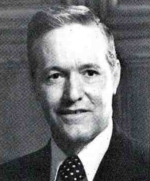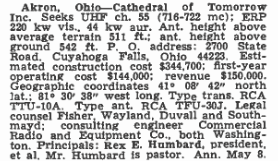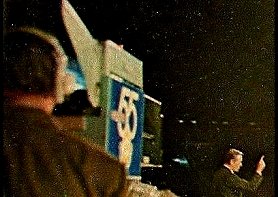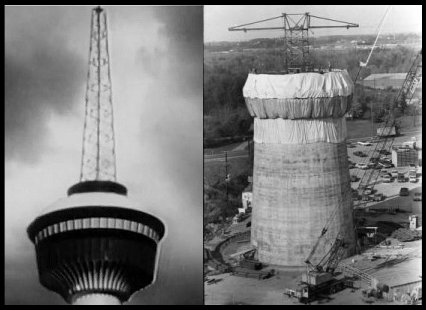by Mark J. Price (original article)
with George Alford, William Bierman, Mark Dawidziak, Peter Geiger, Raymond P. Hart, Joseph E. Keubler, Kay Michael & Doug Oplinger (newspaper articles used for corrections), the editorial staff at Broadcasting in the 1960s and 1970s, an anonymous Wikipedia editor
... and K.M. Richards
This article is a unique entry in the History of UHF Television library. It is the first -- and, we hope, only -- time we are telling the story of a UHF that never got on the air, even for one day.
The station in question is WCOT-TV in the northeast corner of Ohio, and it was to be owned by evangelist Rex Humbard, who had begun his television ministry in 1952, ironically the same year as the first UHF grants. Even so, channel 55 was listed in the original allocations table that year as being a reserved non-commercial channel; in fact, its status was not changed until after WAKR-TV moved to channel 23 from channel 49 in December 1967 and the latter formally made a reserved allocation.

Rev. Rex Humbard |
At the outset, we must disclose that what little had been written about Humbard's would-be station at the time this article was originally posted here (September 2019) got the facts horribly wrong. The Wikipedia entry for today's WBNX-TV had a timeline which is off by as much as a full decade or more. We directly challenged that misinformation, based upon newspaper articles from the time augmented with date checking and other news items in Broadcasting. In the intervening years, the Wikipedia page was edited to remove every single challenged "fact" ... although nowhere was this site credited. (The most recent rewrite, by Nathan Obral, brings the accuracy level up considerably, although we are opting to keep this article as originally written as a historical "bookmark" of sorts as to how misleading the original version of the Wikipedia page was.)
Humbard filed for the channel 55 allocation as WAKR was working with the FCC on its channel 23 application, filing on May 8, 1967; perhaps he presumed he could make the allocation commercial by the time he signed on, and in the meantime his status as a religious organization did not stand in the way of the filing. In any event, the FCC granted his CP on November 17 of that year. By that time, he had already built a full-color production facility at the Cathedral of Tomorrow in order to better serve the 67 stations he was already buying time on, which were gradually shunning monochrome programming. However, Humbard told the Akron Beacon Journal at the time of the channel 55 grant that the station -- to "go into operation next year" -- would be a separate operation emphasizing "matters of community interest and newscasts" even though when he originally applied in May he had pointed out in talking to the newspaper that he already had "everything out here but a transmitter and a tower."
Apparently that last point was what stuck in Humbard's mind, as he continually delayed construction of the transmitting facilities even as he filed the following year to double the tower's height, accompanied by a six-fold increase in effective radiated power. He proceeded to announce September 1, 1970 as the projected sign-on date in an interview with the Cleveland Plain Dealer, even though there was nothing resembling a thousand-foot tower arising at the Cathedral. His original plan to operate from 5:00pm to 11:00pm daily had

Above: Original FCC filing for channel 55.
Below: Channel 55 logo on a camera during Humbard's
television program, even though there was no station. |
become more grandiose in the interim; he now proposed daytime programming "aimed at the housewife" and country-western programming in the evenings, plus area high school and college sports, and religious programming on weekends, with the exception of "Saturday morning cartoons." He told the Beacon Journal much the same thing when they interviewed him the same week, with the addition of proposed religious-themed panel shows with "local churchgoers invited to participate."
By April 1970, Rex Jr. (who ran the teleproduction facility for his father's ministry) said they "hoped to have the station on-air by January 1." They now proposed to use part of a church-owned building adjacent to the Cathedral which had been leased by local discount department store Shoppers Fair until the channel 55 project came along. Still, there was no tower under construction and the renovation of the former retail building was reported as announced -- but not started -- in July. By August, the start-up had been pushed to May 1971 and the city of Cuyahoga Falls was making plans for a new electric substation in the area due to the expected increase in demand once WCOT-TV began operation.
Came the latest missed sign-on date (the Beacon Journal said the date was now "late this Fall" in response to a reader question a month earlier), Rev. Humbard was proposing a 750-foot tower incorporating a 250-seat revolving restaurant near the top and a 190-foot transmitting tower for channel 55 "bearing a giant cross" on the roof. It was said that he had been inspired by the 626-foot Calgary Tower in Alberta, which he had seen while attending a religious rally in that Canadian city. (In the intervening four years since the FCC grant, the Humbard television ministry had grown by almost five times what it had been, and was now buying time on 323 stations in the U.S. and Canada, so it seemed there would be plenty of viewer-provided funding for the tower.) The chairman of the township's zoning board of review was quoted in the Plain Dealer as saying "quite a bit of mixed emotions" existed among board members. Nevertheless, Humbard was granted a conditional permit and was expected to begin construction of what he called "Cathedral Tower" in August.

Left: An artist's rendering of Cathedral Tower, from the introduction to Humbard's weekly
television program. Right: During the whirlwind 22-day construction in November 1971. |
However, it was not until September 10 that the groundbreaking took place and at that time Humbard estimated construction would cost $3.9 million. The tower was to be the tallest building in Ohio and the seventh tallest in the United States. It was November when concrete began to be poured at the site, despite radio station WSLR/1350 filing for an injunction to stop the construction, fearing that the structure would interfere with their signal; the suit was ultimately rejected by the Ohio Supreme Court in February 1973 on the basis of lacking jurisdiction because the tower was connected to the channel 55 authorization, and a second filing by local resident Winifred H. Walker claiming the tower "would be a nuisance" never went to a hearing. For 22 straight days workers operating three shifts, 24 hours a day, poured 19 million pounds of concrete (emptying one cement truck every hour as the tower climbed more than 20 feet a day) around 500,000 pounds of steel reinforcing rods. By the 28th of that month, the tower had reached 494 feet and WCOT-TV was now projected to go on the air "next summer."
Nobody realized that the tower had already reached its peak. Over the next few months, Humbard's ministry would suffer a devastating financial calamity. The Ohio Commerce Department and the U.S. Securities and Exchange Commission accused the ministry of selling unregistered securities to members of its congregation and the Cathedral of Tomorrow eventually had to sell off most of its assets to pay back $12 million in unsecured bonds (see postscript below). Six weeks after the tower work halted, Humbard tried in vain to arrange financing with the Northern Ohio Bank of Cleveland and in January 1972 said WCOT-TV would be on the air "before the end of the year."
In 1973, Humbard scaled back his plans, announcing that the tower would house a museum, library and prayer center instead of a restaurant and TV studio. Five years later, with no further construction on the horizon, Humbard was reduced to saying "someday we'll finish it, and it'll be a landmark."
The FCC had tired of waiting by then, and cancelled the channel 55 authorization August 27, 1976.
This article is based upon one written by Mr. Price that appeared in the Akron Beacon Journal on September 6, 2011 about the unfinished Cathedral Tower. As the newspaper has removed it from their online archives, we have taken the version saved at the Internet Wayback Machine and added information from various sources about WCOT-TV.
POSTSCRIPT
by K.M. Richards
The Wikipedia entry originally went on to say:
The secular programming that was to air on the station was sold to a new station, WCLQ channel 61, and in 1982, Humbard sold the construction permit to Winston Broadcasting, a subsidiary of Ernest Angley Ministries. Construction of the station resumed in 1983.
Obviously, no construction permit existed in 1982 for Humbard to even consider selling, as it had been cancelled by the FCC six years earlier. There is also no documentation even hinting that any programming had been acquired for WCOT-TV, making the claim of selling same to a new station pure speculation (and such a decision would have been made by the syndicators once Humbard defaulted on the contracts for same, had those existed).
What is documented is that in mid-1980 four entities -- Ohio Telecasting Inc., Ebony Blackstar Broadcasting Corp., Rhema Television Corp. and Akron Telecasting Inc. -- applied for the now-vacant channel 55 allocation, and were in comparative hearings for same by the end of 1982. The first two proposed subscription television operation during evening hours, and Akron said it wanted to program a general entertainment station ... which was not surprising, given that some of their investors also had a stake in WPGH-TV/53 Pittsburgh, which had begun its third (and lasting) incarnation six years earlier with the typical independent fare of cartoons, off-network sitcoms and dramas, movies, and religious programs. Rhema was the closest thing to a rebirth of the Humbard vision, being a group of local businessmen and church leaders and originally headed by contractor Clair Pifer, who was president of the Akron chapter of Full Gospel Businessman's Fellowship and a member of the soon-to-be-sold Cathedral of Tomorrow. Their original intent, as stated to the Beacon Journal, was to operate a full-time religious format. However, other than Pifer there was no connection to Humbard, who himself was not part of the group.
Rhema -- by then headed by Dr. Amer Shab, who operated the local Crystal Springs Resort Camp -- was the winner of the new channel 55 grant in 1984 (after merging their application with Akron's during the hearings), but by that time they had already run through the funds they had raised earlier. It was at that point that Ernest Angley finally entered the picture; that summer, he had purchased the ministry's assets from Humbard and renamed the Cathedral of Tomorrow to Grace Cathedral. In mid-1985 he entered into a contract with Rhema-Akron to provide financial support and use of the teleproduction facility at the Cathedral as studios (just as Humbard had intended for WCOT). Lou Spangler, executive director of Angley's ministry, was named program director and said he hoped to have channel 55 on the air "by the end of the year" and "hopefully" in September.
 Spangler's "end of the year" forecast was correct and WBNX-TV went on the air December 1, 1985 under the official ownership of Rhema-Akron. The schedule was dominated by family-friendly sitcoms (including Father Knows Best, Family Affair, and Petticoat Junction), dramas (Ben Casey, Lassie and Death Valley Days), westerns (Marshall Dillon and Hopalong Cassidy), old movies ... and Angley's own national program repeated four times on Saturdays and Sundays plus a local version called The 90 and 9 Club on weekday mornings. The contract between the local group and the ministry was something of a forerunner to today's Local Marketing Agreements in that the latter was responsible for programming on behalf of the former as the licensee.
Spangler's "end of the year" forecast was correct and WBNX-TV went on the air December 1, 1985 under the official ownership of Rhema-Akron. The schedule was dominated by family-friendly sitcoms (including Father Knows Best, Family Affair, and Petticoat Junction), dramas (Ben Casey, Lassie and Death Valley Days), westerns (Marshall Dillon and Hopalong Cassidy), old movies ... and Angley's own national program repeated four times on Saturdays and Sundays plus a local version called The 90 and 9 Club on weekday mornings. The contract between the local group and the ministry was something of a forerunner to today's Local Marketing Agreements in that the latter was responsible for programming on behalf of the former as the licensee.
In January 1987, Rhema-Akron filed to formerly transfer ownership of the station to Grace Cathedral; by the time the sale closed in May, Angley had formed the subsidiary company Winston Broadcasting Network -- based upon his middle name -- to own and operate channel 55. It has continued to operate with a mix of secular and religious programming, was affiliated with The WB and Fox Kids in the 1990s and early 2000s, then was The CW affiliate for the Cleveland market until July 16, 2018.
Humbard passed away in 2007 and Shab, in 2016. Angley died May 7, 2021 at age 99 and still hosted both of his television programs until his death. WBNX-TV continued to be owned by his television ministry for three years after his passing; until recent edits corrected the facts, the Wikipedia entry for him had claimed the Humbard "license" was used to put it on the air.
Cathedral Tower was not included in the sale to Angley; it was purchased by Cuyahoga Falls businessman Mike Krieger at a sheriff's sale for $30,000 in 1989 and is now used as a cell phone tower.
In 2024, Winston Broadcasting sold WBNX to major television station group owner Nexstar, which is expected to transfer the affiliation for The CW network (which it also owns) back to channel 55 in September 2025.



